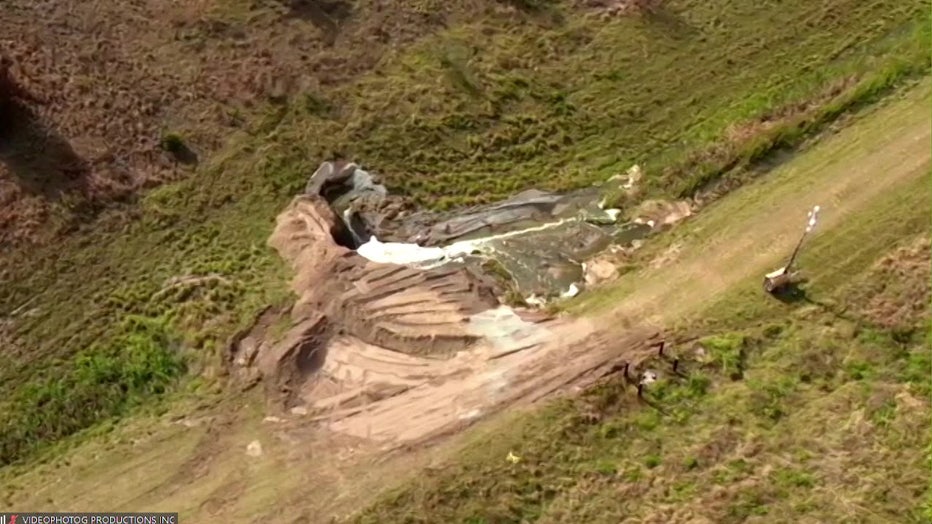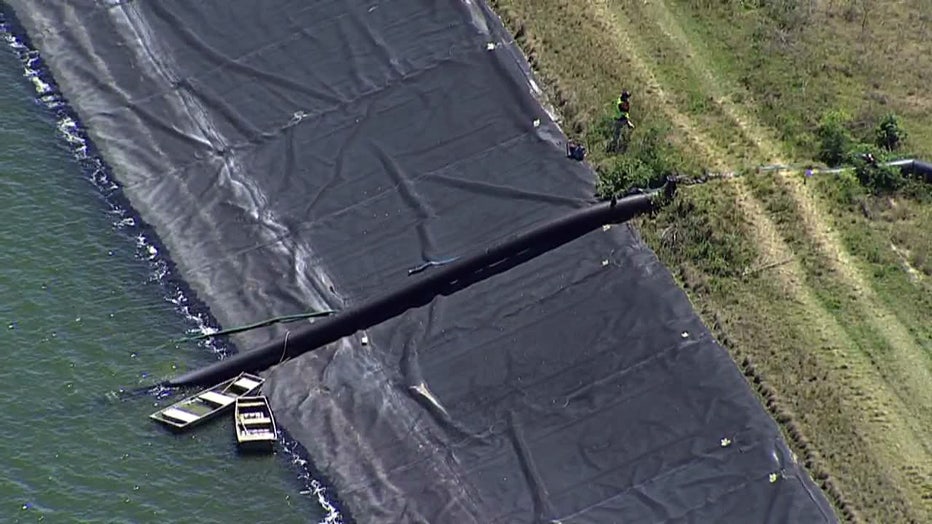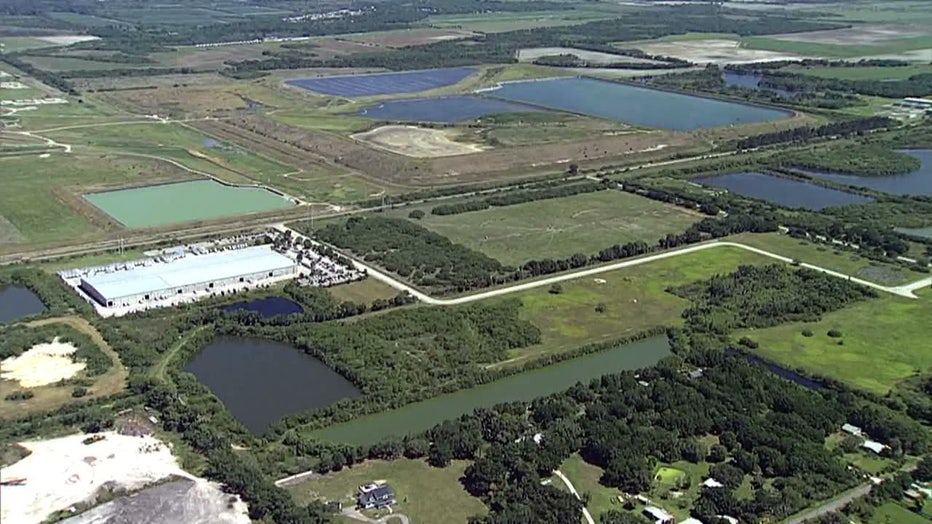Residents evacuated, US-41 closed, state of emergency declared as water continues flowing from Piney Point
PALMETTO, Fla. - Hundreds of residents around Piney Point have been asked to evacuate as 2-3 million gallons of water per day flow from a leak in a containment wall. Officials say the stack collapsed further despite overnight efforts from state and local crews.
On Saturday morning people within a half-mile radius of the site were asked to evacuate. Saturday evening, the evacuation area expanded to include 316 additional homes and several more businesses. Residents one mile to the north and half a mile to the south were asked to evacuate on Friday evening. Officials say the Manatee County Central Jail, which is located to the west of Piney Point is not impacted.
US-41 is also closed south from Buckeye Road to Moccasin Wallow Road. Moccasin Wallow Road will be closed west of 38th Avenue East.
Residents within the evacuation zone who need help are asked to call Manatee County's 311 Call Center, which will connect residents with Red Cross resources.
Florida Governor Ron DeSantis issued a state of emergency for Manatee, Hillsborough and Pinellas Counties Saturday afternoon due to a possible breach of mixed saltwater from the south reservoir at the Piney Point facility. DeSantis said he issued the order to ensure resources are allocated for necessary response & recovery.
Senator Rick Scott also pledged to secure any federal assistance deemed necessary by state and local officials.
A leak in the containment wall has been ongoing at the Piney Point facility for the past week.
During a press conference on Saturday afternoon, officials said a portion of the containment wall at the leak site shifted laterally, signifying that a collapse could occur at any time.
"You’ve got an immense volume of water. You’ve got 77 acres and it goes 25 feet deep," Manatee County Acting Administrator Scott Hopes explained. "So, when you think of your bathtub, where you have this minuscule amount of water, you can imagine when you have that kind of volume and depth of water putting pressure on that."

Hopes says there are three ponds of water at Piney Point with approximately one billion gallons of water. The leak is located in a seam of the liner at the east, southeast corner of one of those ponds, according to Hopes. He says that the concern is that if that liner continues to ‘unzip,’ that crevice where the breach occurred will unzip and break the rock away.
According to Hopes, the water in the pond with the leak is currently sustaining wildlife. He says he saw fish and ducks swimming in the water on Friday. However, that is not the case for the other two ponds.

Currently, Hopes says 22,000 gallons of water per minute is being pumped out of the pond and into Tampa Bay in a controlled fashion. At that rate, it will take 10-12 days to deplete the supply that’s currently in the pond.
He added, "The more time we have for a controlled release, the minimization of the uncontrolled….Every minute we go without a full breach occurring is reducing the volume of water that would go into the surrounding land."
Hopes says that if a full breach occurs it could destabilize the area.

"The risk factor is the potential release of nearly one billion gallons of water," he shared. "We’re talking about the potential of 600 million gallons within a matter of seconds, minutes, leaving that retention pond and going into the surrounding areas."
Though the surrounding area is sparsely populated and residents have been evacuated, some of the water is saltwater, which doesn’t go well with the crops.
Hopes explained that the low-lying areas surrounding Piney Point would absorb some of the water, so there would be an initial ‘sheet’ of flow, which would migrate to the north and follow the terrain into Tampa Bay. Officials hope the south would be protected by borrow pits that are already in place.
Hopes says the goal now is to move as much water as possible in a controlled fashion and possibly flood Piney Point low areas so the water stays on Piney Point grounds with as much volume as possible. He added that what is being released in a controlled fashion isn't as bad as what officials are trying to prevent from leaving in an uncontrolled way.

WHAT IS PINEY POINT?
Piney Point is an abandoned phosphate plant located north of Palmetto, in Manatee County, near the coastline of lower Tampa Bay. The plant was built in 1966 and produced fertilizer for decades until it was officially abandoned by Mulberry Corporation in 2001. The plant is located in an environmentally sensitive area, near Bishop Harbor and the Terra Ceia Aquatic Preserve.
WHAT REMAINS AT THE SITE?
Gypsum stacks and ponds full of wastewater. Both are byproducts of fertilizer production and both are environmental hazards. Phosphogypsum is a slightly radioactive byproduct with no commercial value. It is an industry practice to store it in stacks and there are two stacks at the Piney Point site.
Also on the site are ponds full of water contaminated with nutrients and heavy metals, like cadmium, held back by aging dams. The water, used in the process of producing fertilizer, is corrosive and acidic. The ponds have reached capacity numerous times over the years, requiring emergency releases into Tampa Bay. The water is toxic to the marine environment and has been linked to harmful algae blooms.
WHAT’S HAPPENING NOW?
On March 27, crews detected a leak in one of the containment walls holding back 480 million gallons of contaminated water. That wall is now in danger of collapsing. Such a failure would likely flood nearby homes as the toxic water washes toward Tampa Bay. The impacts on marine life would be devastating.
Thursday, commissioners heard a report from the engineer of record from HRK Holdings, the company that manages the wastewater holding stack.
Mike Kelly told commissioners "uncontrolled release is a real possibility at this stage…That uncontrolled release puts a pretty significant danger to environmental and public health."
WHO IS RESPONSIBLE FOR THE SITE?
Mulberry Corporation filed for bankruptcy and officially abandoned the plant in 2001. The Department of Environmental Protection took responsibility for the plant until 2006 when HRK Holdings acquired the property and became responsible for managing operations at the site. HRK had intended to turn the property into a shipping terminal.
TROUBLED HISTORY
In 2001, heavy rains from Tropical Storm Gabrielle threatened to overflow the ponds and cause a catastrophic release of wastewater. DEP, which was responsible for maintaining water levels at the time, released 10 million gallons of lime-treated water into Bishop Harbor, a marine estuary leading into Tampa Bay.
In 2003, DEP received permission from the Environmental Protection Agency to dump partially treated wastewater 100 miles offshore in the Gulf of Mexico, after a storm dumped 16.5 inches of rain on Piney Point, once again threatening to overflow the ponds.
In 2011, a liner on one of the gypsum stacks was punctured, causing water to leak through the stack, picking up pollutants along the way. The DEP ordered the pond to be drained and the liner repaired. 170 million gallons of contaminated water were dumped into Bishop Harbor and lower Tower Bay.
This is a developing story. Check back for updates.

